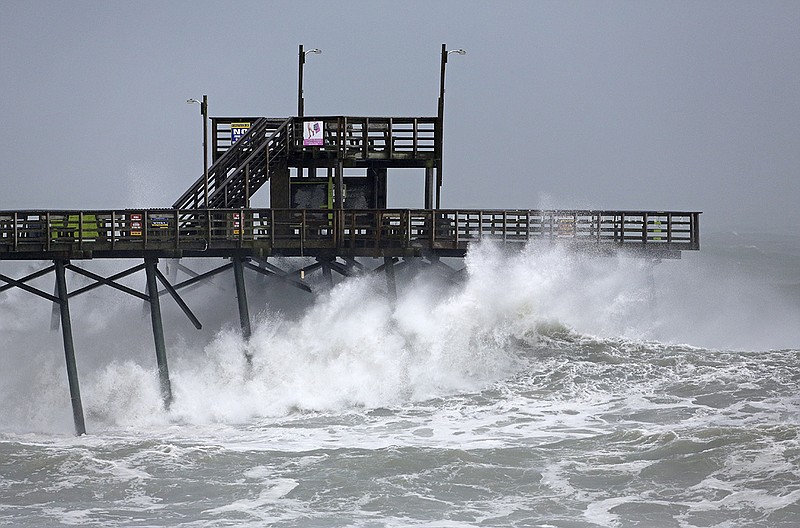You hear it now every time a hurricane makes landfall on the United States mainland. The hurricane, a climate alarmist will warn, is further proof of climate change.
The charge is picked up by clueless members of the national media, fed by the industry of environmental extremism, exacerbated by the Al Gores of the world and is thus assumed to be fact by too many non-curious Americans.
A recent Facebook post about the former Hurricane Florence caught our attention: "I wonder if the Florence destruction," the poster said, "is enough to convince the doubters of climate change/global warming?"
We looked for the poster's comparison of this hurricane to previous ones, of this season to other seasons, of anything that would justify such a claim. There was nothing.
But actual scientists have spoken out, have compared data, have studied seasons.
Among them, Roy Spencer, a meteorologist, former NASA climate scientist and principal research scientist at the University of Alabama at Huntsville, told The Washington Times "that there has been no long-term change in global hurricane activity," and there even has been "a 50 percent decrease in U.S. landfalling major hurricanes over the last 80 years."
Roger A. Pielke Jr., a University of Colorado professor who has similarly researched hurricanes, released a graphic just before Hurricane Florence's U.S. arrival that showed hurricanes making landfall in the U.S. declined from 1900 to 2017.
"Most people simply don't believe that U.S. landfalling hurricanes (overall & major) are down since 1900 (within population, but not significantly if taken as a sample)," he tweeted, according to The Washington Times. "I've found these graphs get people riled up, but it's just data."
Nevertheless, The Washington Post, in an editorial, said President Donald Trump was "complicit" in Hurricane Florence. The Post's sister newspaper on the left fringe, The New York Times, called out Trump for ignoring the "linkage" between hurricanes and his policies.
(As an aside, we hope the president's aides kept him from reading those reports for fear that such power might go to his head. He'll be wanting the hurricanes directed at certain Washington, D.C., addresses.)
In this day, where Americans have more and more trouble separating fact from fiction, here is a fact that is easy to check: Until 2017, the U.S. went 11 years without a major hurricane strike (Category 3 or higher), a most improbable scenario. Spencer said a NASA scientist called it a 1-in-177-year event.
But, wait. That goes against everything climate alarmists predicted after Hurricane Katrina in 2005. Hurricanes hitting the U.S. would get bigger, would be more frequent and would be more destructive, they said.
Well, they got one out of three right. Hurricanes are more destructive because, frankly, we've built more homes, condos and hotels closer to the water; we've accumulated more in our homes, and have boats, other water craft and cars besides; and we've built more places to shop for all the things that fill up those homes, boats and cars. When a hurricane does strike, it's got a lot to destroy.
Hurricane Florence certainly did that and continues to do that as its low spins back out toward the Atlantic Ocean. But, statistically, a major hurricane hits the North Carolina coast only once about every 20 years. The last of those was Fran in 1996, 22 years ago.
A popular theory is that hurricanes have slowed down in speed by about 10 percent over the past 70 years due to the movement of the jet stream over the U.S. farther north. The hurricanes, thus less affected by jet stream-producing steering currents, stall and dump more rain over a smaller area.
But Spencer, writing in USA Today, says even changes over 70 years can be part of natural weather patterns or are incomplete data.
While the jet stream at this point in the year is, in fact, pushed farther north over the area where Hurricane Florence came ashore, it is pushed farther south over western North America.
"This kind of natural variation in atmospheric flow is called weather," Spencer says, "not climate change."
Stanley Goldenberg, a NOAA/AOML Hurricane Research Division meteorologist, posited similar thoughts during a panel last weekend at the Independent Institute in Oakland, California.
"We have not seen anything to indicate we're in an unprecedented time of more hurricanes, stronger hurricanes, if you know how to read the historical record," he said.
Goldenberg said atmospheric conditions, wind shear and interaction with land, plus a warmer sea, are among the variables that determine what will happen with a hurricane.
Indeed, rather than Hurricane Florence being anything unusual, he said, "We've seen this stuff before. It doesn't shock us when a storm sits there, meanders and stalls. We've seen this many, many, many times."
That didn't make her more welcome, but that explanation - and not climate change - does indicate why she stuck around long enough to wear out her welcome.
